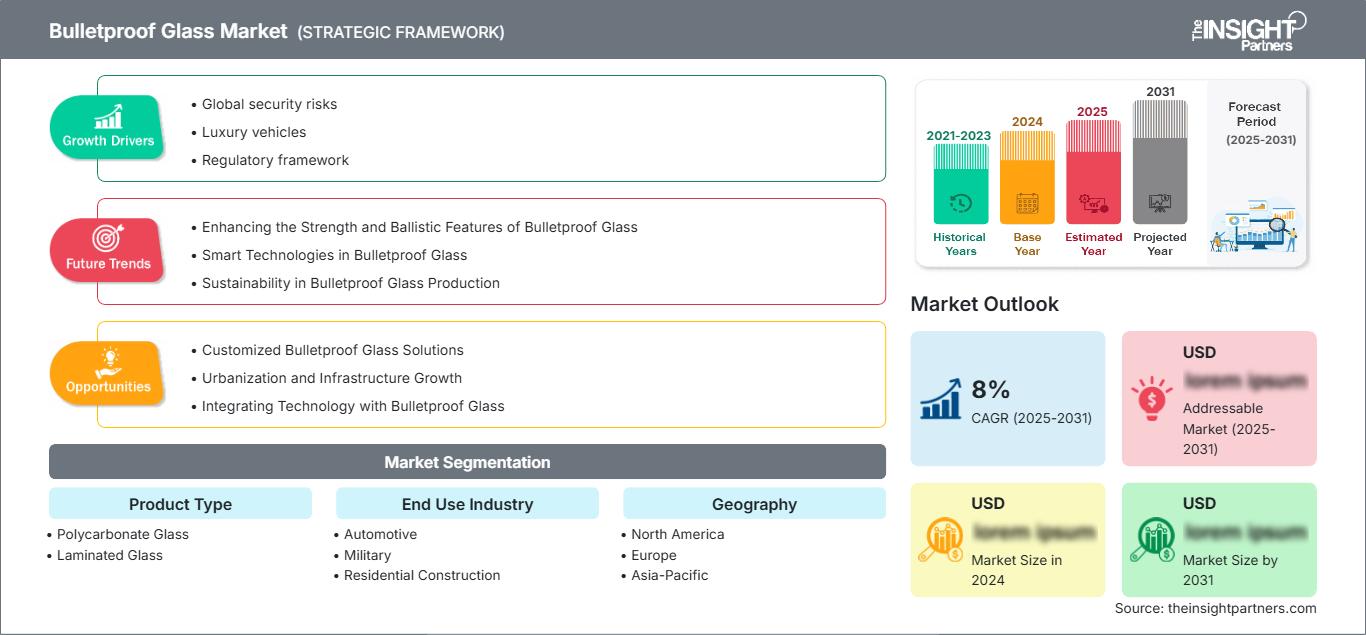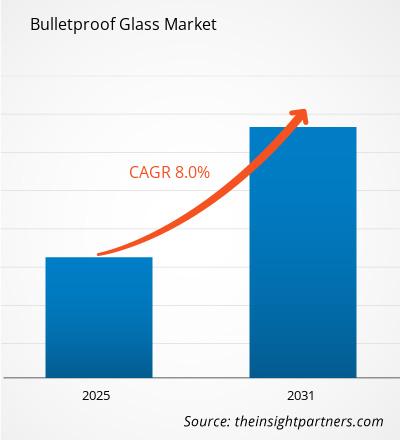Si prevede che il mercato del vetro antiproiettile raggiungerà i 17,21 miliardi di dollari entro il 2031. Si prevede che il mercato registrerà un CAGR del 10,5% nel periodo 2025-2031.
Il rapporto è segmentato per tipologia di prodotto (vetro in policarbonato, vetro stratificato e altri). Il rapporto presenta inoltre un'analisi basata sul settore di utilizzo finale (settore automobilistico, militare, edilizia residenziale, edilizia commerciale e altri). L'analisi globale è ulteriormente suddivisa a livello regionale e per i principali paesi. Le dimensioni del mercato e le previsioni a livello globale, regionale e nazionale per tutti i principali segmenti di mercato sono trattate nell'ambito di applicazione. Il rapporto fornisce il valore in dollari USA per l'analisi e i segmenti sopra indicati. Il rapporto fornisce statistiche chiave sullo stato del mercato dei principali attori e offre tendenze e opportunità di mercato.
Scopo del rapporto
Il rapporto Bulletproof Glass Market di The Insight Partners mira a descrivere il panorama attuale e la crescita futura, i principali fattori trainanti, le sfide e le opportunità. Ciò fornirà approfondimenti a vari stakeholder aziendali, come:
- Fornitori/produttori di tecnologia: per comprendere le dinamiche di mercato in evoluzione e conoscere le potenziali opportunità di crescita, consentendo loro di prendere decisioni strategiche informate.
- Investitori: per condurre un'analisi completa delle tendenze in merito al tasso di crescita del mercato, alle proiezioni finanziarie di mercato e alle opportunità esistenti lungo la catena del valore.
- Organismi di regolamentazione: per regolamentare le politiche e le attività di polizia nel mercato con l'obiettivo di ridurre al minimo gli abusi, preservare la fiducia degli investitori e sostenere l'integrità e la stabilità del mercato.
Segmentazione del mercato del vetro antiproiettile Tipo di prodotto
- Vetro in policarbonato
- Vetro laminato
Settore di utilizzo finale
- Automotive
- Militare
- Edilizia residenziale
- Edilizia commerciale
Potrai personalizzare gratuitamente qualsiasi rapporto, comprese parti di questo rapporto, o analisi a livello di paese, pacchetto dati Excel, oltre a usufruire di grandi offerte e sconti per start-up e università
Mercato del vetro antiproiettile: Approfondimenti strategici

-
Ottieni le principali tendenze chiave del mercato di questo rapporto.Questo campione GRATUITO includerà l'analisi dei dati, che vanno dalle tendenze di mercato alle stime e alle previsioni.
Fattori di crescita del mercato del vetro antiproiettile
- Rischi per la sicurezza globale: con l'aumento dei rischi per la sicurezza globale, in particolare in settori come il terrorismo, la criminalità violenta e i disordini civili, si registra un aumento della domanda di migliori meccanismi di protezione. Ad esempio, anche istituzioni governative, fornitori di servizi finanziari avanzati e sistemi di trasporto urbano hanno iniziato a utilizzare il vetro antiproiettile per mitigare le minacce. Le crescenti preoccupazioni in materia di sicurezza hanno contribuito alla crescente accettazione del vetro antiproiettile sia nel settore commerciale che in quello residenziale.
- Veicoli di lusso: la protezione dei veicoli di lusso ha registrato un crescente utilizzo della tecnologia del vetro antiproiettile, soprattutto nel caso di auto blindate utilizzate per il trasporto passeggeri e di flotte di veicoli noleggiate da funzionari governativi. Personalità di alto profilo del settore pubblico e privato sono più esigenti in termini di trasporto, in particolare per i veicoli dotati di spessi scudi antiproiettile installati.
- Quadro normativo: diverse normative, autorità e altri standard pertinenti hanno sviluppato leggi e politiche che regolano la sicurezza dei materiali da costruzione. Tali leggi, ad esempio, includono l'installazione di materiali di sicurezza o antiurto in determinati edifici, soprattutto in caso di calamità naturali o ad alto rischio di criminalità. Di conseguenza, tali requisiti di conformità stanno spingendo molte aziende a includere il vetro antiproiettile nei loro progetti, con conseguente aumento della crescita del mercato.
Tendenze future del mercato del vetro antiproiettile
- Miglioramento della resistenza e delle caratteristiche balistiche del vetro antiproiettile: la domanda di vetro antiproiettile sta assistendo a un progresso grazie allo sviluppo nel settore della scienza dei materiali, da cui l'emergere di materiali per vetrate efficaci. La ricerca e lo sviluppo nella tecnologia del policarbonato e del vetro stratificato hanno migliorato la resistenza del vetro antiproiettile e le sue caratteristiche balistiche, rendendolo disponibile per un'ampia gamma di mercato. Questi sviluppi si sono concentrati sul miglioramento delle caratteristiche di sicurezza e sul mantenimento della trasparenza.
- Tecnologie intelligenti nel vetro antiproiettile: l'applicazione di tecnologie intelligenti nelle vetrate antiproiettile sta cambiando le dinamiche di mercato. Le innovazioni sul mercato includono l'inclusione di materiali o sensori autoriparanti e rivestimenti intelligenti per migliorare la qualità delle immagini e la sicurezza. Queste innovazioni consentono di monitorare le minacce, il che significa che il vetro antiproiettile viene applicato per tenere a bada le minacce, ma è anche una misura orientata al mantenimento della sicurezza.
- Sostenibilità nella produzione di vetro antiproiettile: con l'affermarsi del concetto di economia verde, l'enfasi viene posta sulla produzione di vetro antiproiettile utilizzando tecnologie e materiali ecocompatibili. La crescente domanda di un uso appropriato delle risorse e il miglioramento delle pratiche di gestione della qualità sono stati integrati nelle operazioni generali di produzione di prodotti in vetro, inclusi materiali riciclati. Questa trasformazione contribuisce a ridurre gli effetti negativi sull'ambiente e crea anche opportunità per servire il mercato che richiede prodotti ecologici sostenibili.
Opportunità di mercato per il vetro antiproiettile
- Soluzioni personalizzate per vetro antiproiettile: l'evoluzione dei requisiti di sicurezza da un settore all'altro offre ai produttori un'opportunità redditizia di fornire soluzioni personalizzate per vetro antiproiettile. Prodotti su misura che mirano a soluzioni specifiche, come diverse classificazioni balistiche o l'integrazione in strutture esistenti, consentono di soddisfare un'ampia gamma di clienti. Collaborare con architetti e progettisti per offrire tali servizi può essere vantaggioso per garantire la penetrazione del mercato.
- Crescita dell'urbanizzazione e delle infrastrutture: nei paesi in via di sviluppo, il tasso di urbanizzazione e industrializzazione è stato enorme nel corso degli anni, con conseguente moltiplicazione dello sviluppo edilizio e infrastrutturale. Si prevede che questo fattore favorirà l'industria del vetro antiproiettile, poiché in queste aree si sta gradualmente creando una domanda di sicurezza nei luoghi pubblici e negli edifici commerciali. Questa tendenza può essere sfruttata dai produttori anche attraverso la collaborazione con appaltatori edili locali e istituzioni governative per la fornitura di vetro antiproiettile da utilizzare nelle costruzioni in corso.
- Integrazione della tecnologia con il vetro antiproiettile: l'integrazione della tecnologia nel vetro antiproiettile apre nuove opportunità di collaborazione con aziende tecnologiche che forniscono prodotti per la sicurezza. Ciò consente ai produttori di vetro antiproiettile di creare un prodotto avanzato che include anche altri sistemi di sicurezza come sistemi di accesso biometrici e sistemi di videosorveglianza. Tale combinazione contribuisce a creare un sistema di sicurezza che attrae le persone, ampliando così la loro gamma di prodotti e migliorando la loro posizione sul mercato.
Le tendenze regionali e i fattori che influenzano il mercato del vetro antiproiettile durante il periodo di previsione sono stati ampiamente spiegati dagli analisti di The Insight Partners. Questa sezione illustra anche i segmenti e la geografia del mercato della gestione delle malattie del ritmo cardiaco in Nord America, Europa, Asia-Pacifico, Medio Oriente e Africa, America meridionale e centrale.
Ambito del rapporto di mercato del vetro antiproiettile
| Attributo del rapporto | Dettagli |
|---|---|
| Dimensioni del mercato in 2024 | US$ XX Billion |
| Dimensioni del mercato per 2031 | US$ 17.21 Billion |
| CAGR globale (2025 - 2031) | 10.5% |
| Dati storici | 2021-2023 |
| Periodo di previsione | 2025-2031 |
| Segmenti coperti |
By Tipo di prodotto
|
| Regioni e paesi coperti |
Nord America
|
| Leader di mercato e profili aziendali chiave |
|
Densità degli operatori del mercato del vetro antiproiettile: comprendere il suo impatto sulle dinamiche aziendali
Il mercato del vetro antiproiettile è in rapida crescita, trainato dalla crescente domanda degli utenti finali, dovuta a fattori quali l'evoluzione delle preferenze dei consumatori, i progressi tecnologici e una maggiore consapevolezza dei vantaggi del prodotto. Con l'aumento della domanda, le aziende stanno ampliando la propria offerta, innovando per soddisfare le esigenze dei consumatori e sfruttando le tendenze emergenti, alimentando ulteriormente la crescita del mercato.

- Ottieni il Mercato del vetro antiproiettile Panoramica dei principali attori chiave
Punti di forza
- Copertura completa: il rapporto analizza in modo esaustivo prodotti, servizi, tipologie e utenti finali del mercato del vetro antiproiettile, fornendo un panorama olistico.
- Analisi degli esperti: il rapporto è redatto sulla base della conoscenza approfondita di esperti e analisti del settore.
- Informazioni aggiornate: il rapporto garantisce la pertinenza aziendale grazie alla copertura di informazioni e tendenze dei dati recenti.
- Opzioni di personalizzazione: questo rapporto può essere personalizzato per soddisfare le esigenze specifiche del cliente e adattarsi in modo appropriato alle strategie aziendali.
Il rapporto di ricerca sul mercato del vetro antiproiettile può quindi aiutare a guidare il percorso di decodificazione e comprensione dello scenario del settore e delle prospettive di crescita. Sebbene possano esserci alcune preoccupazioni valide, i vantaggi complessivi di questo rapporto tendono a superare gli svantaggi.
- Analisi storica (2 anni), anno base, previsione (7 anni) con CAGR
- Analisi PEST e SWOT
- Valore/volume delle dimensioni del mercato - Globale, Regionale, Nazionale
- Industria e panorama competitivo
- Set di dati Excel
Report recenti
Rapporti correlati
Testimonianze
Motivo dell'acquisto
- Processo decisionale informato
- Comprensione delle dinamiche di mercato
- Analisi competitiva
- Analisi dei clienti
- Previsioni di mercato
- Mitigazione del rischio
- Pianificazione strategica
- Giustificazione degli investimenti
- Identificazione dei mercati emergenti
- Miglioramento delle strategie di marketing
- Aumento dell'efficienza operativa
- Allineamento alle tendenze normative






















 Ottieni un campione gratuito per - Mercato del vetro antiproiettile
Ottieni un campione gratuito per - Mercato del vetro antiproiettile